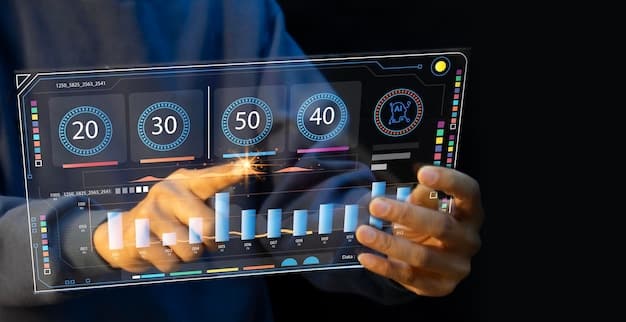Future of Hybrid Work: 4 Strategies for Success

The future of work is undeniably hybrid, necessitating a strategic approach to integrate remote and in-office models effectively, fostering collaboration, productivity, and employee well-being for organizational resilience and growth in a blended environment.
The global pandemic undeniably accelerated a shift that was already bubbling beneath the surface of the modern workplace: the embrace of flexible work models. Today, The Future of Work is Hybrid: 4 Strategies for Success in a Blended Environment is not just a catchy phrase, but a definitive reality transforming how businesses operate and how individuals approach their careers. This pivotal evolution demands a nuanced understanding and proactive implementation of strategies that transcend traditional office-centric paradigms, shaping a more dynamic, inclusive, and efficient professional landscape.
Understanding the Hybrid Work Revolution
The transition to hybrid work represents more than just a change in location; it’s a fundamental reimagining of organizational design, culture, and operational rhythms. In this new era, companies are tasked with balancing the benefits of in-person collaboration with the flexibility and autonomy that remote work provides. It’s about creating a harmonious ecosystem where employees can thrive, regardless of their physical proximity to the office. This model recognizes that a one-size-fits-all approach no longer serves the diverse needs of a modern workforce, encouraging a more personalized and adaptable work experience.
This shift isn’t without its complexities. Leaders often grapple with maintaining a cohesive culture, ensuring equitable opportunities, and optimizing technology infrastructures to support seamless collaboration across distributed teams. The success of hybrid work hinges on proactive planning and a deep understanding of both human behavior and technological capabilities. Businesses must navigate these challenges while simultaneously capitalizing on the potential for increased productivity, reduced overheads, and a broader talent pool. Organizations that embrace this revolution thoughtfully are poised to gain a significant competitive edge in attracting and retaining top talent.
The Evolution of Workplace Dynamics
The traditional 9-to-5, in-office model, once the unquestioned standard, has been progressively challenged by technological advancements and evolving societal expectations. The pandemic merely accelerated a trajectory towards greater flexibility. Now, hybrid work scenarios are becoming the norm, driven by employee demand for better work-life balance and employer recognition of enhanced productivity and reduced costs. This evolution necessitates a re-evaluation of management styles, moving from command-and-control to trust and empowerment.
Organizations are finding that simply allowing remote work isn’t enough; they must actively cultivate an environment that supports both in-office and remote workers equally. This involves intentional strategies for communication, collaboration, and career development.
- Increased Employee Autonomy: Workers gain more control over their schedules and work environments.
- Expanded Talent Pool: Companies can hire beyond geographical limitations, accessing diverse skills.
- Cost Efficiencies: Potential reductions in office space, utilities, and commuting expenses.
- Enhanced Work-Life Integration: Greater flexibility to balance personal and professional commitments.
Defining Hybrid Models
There isn’t a single definition of hybrid work; it manifests in various forms. Some companies adopt a “fixed schedule” model, where employees come to the office on specific days. Others prefer a “flexible schedule,” allowing teams to decide their in-office days. Then there’s the “remote-first” approach, where the default is remote, with office visits for specific events or team-building. Each model has its pros and cons, and the optimal choice often depends on the industry, company size, and specific team needs. Understanding these nuances is crucial for tailoring a hybrid strategy that truly fits an organization’s context. The ultimate goal is to create a model that supports productivity, collaboration, and employee well-being across the entire workforce, ensuring that no group feels marginalized.
Strategy 1: Cultivating an Inclusive Culture for All
Building a thriving hybrid environment starts with culture. An inclusive hybrid culture ensures that both in-office and remote employees feel connected, valued, and have equal opportunities for growth and recognition. This goes beyond mere policies; it involves intentional efforts to bridge distance gaps and foster a sense of belonging for everyone. Without a strong, inclusive culture, the benefits of hybrid work can quickly erode, leading to divisions and disengagement within the workforce. Leaders must actively champion this inclusivity, setting the tone for interactions and expectations.
The foundation of an inclusive hybrid culture lies in transparent communication and equitable practices. It means actively working to counteract potential “proximity bias,” where in-office employees might inadvertently receive more opportunities or attention. This requires managers to be acutely aware of how decisions are made, how feedback is given, and how collaboration is facilitated, ensuring fairness for all. The goal is to create a unified experience, despite geographical distribution, where every team member feels like an integral part of the organization’s success.
Bridging the Physical Distance
The physical separation inherent in hybrid models can lead to feelings of isolation for remote workers and unintentional bias towards those in the office. To counteract this, organizations must implement deliberate strategies to connect employees. This includes providing high-quality collaboration tools, scheduling regular virtual check-ins that are as engaging as in-person meetings, and creating informal channels for social interaction. Managers play a crucial role in ensuring remote employees are actively involved in discussions and decision-making processes, preventing them from being overlooked.
It’s equally important to design office spaces that facilitate collaboration and connection when teams do come together. These spaces should encourage interaction and foster a sense of community, making occasional office visits feel purposeful and rewarding. The office transforms from a daily workspace into a hub for strategic collaboration and relationship building.

Fostering Psychological Safety
In a hybrid setting, psychological safety becomes even more critical. Employees need to feel safe to express ideas, ask questions, and admit mistakes without fear of retribution, regardless of their location. This trust is paramount for innovation and problem-solving. Leaders can build psychological safety by actively soliciting feedback from all team members, being vulnerable themselves, and creating an environment where dissent is seen as constructive. Regular one-on-ones, anonymized surveys, and clear conflict resolution processes contribute significantly to this.
Ensuring Equitable Opportunities
One of the biggest challenges in hybrid work is ensuring equitable opportunities for career advancement, mentorship, and development for both remote and in-office staff. Proximity bias can unintentionally lead to in-office employees being favored. To combat this, companies should:
- Implement structured mentorship programs that pair employees regardless of location.
- Ensure performance reviews and promotion processes are transparent and bias-free, focusing on outcomes rather than face time.
- Provide identical access to training and development resources for all employees.
- Actively promote remote employees for leadership roles and project assignments.
This conscious effort to level the playing field is essential for retaining top talent and building a truly inclusive workforce.
Strategy 2: Empowering Leaders for a Blended Environment
The success of any hybrid model rests heavily on the capabilities of its leaders. Traditional management skills, while still valuable, must evolve to encompass the unique demands of a blended environment. Empowering leaders means equipping them with the tools, training, and mindset necessary to effectively manage, motivate, and mentor teams across different locations. This shift requires a focus on empathy, results-oriented management, and proficiency in digital collaboration tools. Leaders become not just managers, but facilitators of connection and productivity, regardless of where their team members are working.
Effective leadership in a hybrid setting involves a delicate balance of trust, flexibility, and clear communication. Leaders need to move away from micromanagement and towards outcome-based performance evaluations. They must learn to interpret digital cues, maintain team cohesion across screens, and actively foster a culture of accountability and support. This empowerment isn’t just about training; it’s about fundamentally changing the approach to leadership, recognizing that the future of work demands a more adaptable and human-centric style of management.
Developing New Leadership Competencies
Leading a hybrid team requires a distinct set of skills beyond those needed for an entirely in-person or fully remote setup. Leaders must become adept at:
- Digital Communication: Mastering various asynchronous and synchronous communication tools to ensure clarity and engagement.
- Output-Focused Management: Shifting from monitoring hours to evaluating tangible results and contributions.
- Empathy and Flexibility: Understanding and accommodating the diverse needs and challenges of individual team members, whether remote or in-office.
- Building Virtual Community: Proactively creating opportunities for team bonding and social interaction online.
Investing in extensive training and development programs for managers is crucial to equip them with these competencies. Leadership development should focus on practical strategies for managing distributed teams, fostering inclusion, and maintaining high levels of engagement and productivity.
Facilitating Effective Communication
Clear, consistent, and intentional communication is the bedrock of successful hybrid teams. Leaders must establish clear communication protocols, determining which channels are best suited for different types of interactions (e.g., instant messaging for quick updates, video calls for discussions, email for formal announcements). They should also model good communication habits, ensuring all team members, regardless of location, have equal access to information and opportunities to contribute. This includes scheduling meetings at times that accommodate different time zones where applicable and actively encouraging participation from remote colleagues.
Adopting a Coaching Mindset
In a hybrid environment, a coaching mindset becomes invaluable for leaders. Instead of simply dictating tasks, effective leaders act as coaches, guiding their team members, fostering their development, and empowering them to find solutions. This involves active listening, providing constructive feedback, and encouraging autonomy. A coaching approach helps build resilience and self-sufficiency within teams, which is essential when direct oversight is less frequent. It cultivates an environment where employees feel trusted and supported in their professional growth, leading to higher job satisfaction and better performance.
Strategy 3: Optimizing Technology and Digital Infrastructure
Technology is the backbone of any successful hybrid work setup. Without a robust and intuitive digital infrastructure, the promise of flexibility and connectivity breaks down. Optimizing technology means not just providing tools, but ensuring they are integrated, user-friendly, and accessible to everyone, everywhere. This involves ongoing investment, thoughtful implementation, and continuous evaluation to keep pace with evolving needs and technological advancements. A well-designed digital ecosystem can erase geographical boundaries, making collaboration feel seamless and efficient for all employees.
The goal is to create a digital “office” that is as functional and engaging as a physical one, if not more so. This extends beyond basic video conferencing to include comprehensive project management platforms, secure cloud storage, and reliable communication channels. Strategic technology optimization minimizes friction, reduces frustration, and maximizes productivity, allowing teams to focus on their work rather than struggling with tools. It’s about enabling work, not impeding it, and ensuring that no employee is disadvantaged by their chosen work location.
Investing in Seamless Collaboration Tools
For hybrid teams, the right tools are not just convenient; they are essential for productivity and cohesion. Companies need to invest in a suite of integrated platforms that support:
- Video Conferencing: High-quality, reliable platforms that facilitate engaging virtual meetings.
- Project Management: Tools that allow teams to track progress, assign tasks, and manage workflows transparently.
- Instant Messaging: Channels for quick, informal communication and information sharing.
- Document Collaboration: Cloud-based solutions that enable real-time co-editing and version control.
The key is integration, ensuring these tools work together harmoniously to create a frictionless experience for employees. Training on these tools is also paramount to ensure universal adoption and proficiency.
Ensuring Cybersecurity and Data Protection
With a distributed workforce accessing company resources from various locations and devices, cybersecurity becomes a paramount concern. Organizations must implement robust security protocols, including multi-factor authentication, secure VPNs, and comprehensive employee training on data protection best practices. Regular security audits and updates are essential to protect sensitive company information from potential threats. A single breach can have devastating consequences, making cybersecurity a non-negotiable aspect of hybrid work.
Enhancing Digital Equity
Digital equity ensures that all employees have the necessary access to reliable internet, hardware, and software, regardless of their location or socioeconomic status. Companies should consider providing stipends for home office setups, subsidizing internet costs, and offering IT support tailored to remote environments. Neglecting digital equity can create significant disparities, hindering productivity and engagement for those with inadequate resources. It’s about leveling the playing field so that every team member can perform at their best.
Strategy 4: Redefining Performance and Productivity Metrics
In a hybrid work model, the traditional ways of measuring performance, often focused on “face time” or hours spent in the office, become obsolete. Redefining performance and productivity metrics means shifting to an outcome-based approach, focusing on tangible results, goal achievement, and contributions. This change requires a clear articulation of expectations, robust systems for tracking progress, and ongoing feedback loops that support continuous improvement. It acknowledges that quality of output, not presence, is the ultimate measure of success.
This strategy frees employees from rigid structures, allowing them greater autonomy over how and when they achieve their objectives. For leaders, it demands a move towards more strategic oversight and less micromanagement. By clearly defining success through measurable outcomes, organizations can foster a culture of accountability and trust, where employees are empowered to deliver their best work from anywhere. This redefinition is crucial for maintaining high performance standards and ensuring fairness in evaluations across a blended workforce.
Shifting to Outcome-Based Performance
The cornerstone of evaluating hybrid performance is a clear shift to outcome-based metrics. This means defining what success looks like in terms of deliverables, project completions, and measurable impacts, rather than focusing on hours worked or physical presence. Goals should be SMART (Specific, Measurable, Achievable, Relevant, Time-bound) and regularly reviewed. This approach empowers employees by giving them autonomy over their work processes, fostering trust, and encouraging personal responsibility for results. It also reduces the potential for “presenteeism” (being present but not productive) and promotes genuine efficacy.
Regular check-ins and performance reviews should focus on progress toward these outcomes, identifying challenges, and providing support. This dialogue nurtures continuous improvement and ensures alignment with organizational objectives.
Implementing Clear Goal Setting and Tracking
Effective goal setting and transparent tracking mechanisms are vital in a hybrid environment. Everyone needs to understand their individual contributions to larger team and organizational objectives. Utilizing project management software or dedicated goal-tracking platforms can help visualize progress, identify bottlenecks, and ensure accountability. This transparency fosters a sense of shared purpose and allows managers to intervene proactively if goals are at risk.
It’s also important to establish regular reporting cycles that are consistent for all employees, regardless of their location. This ensures that performance data is collected uniformly and can be used for fair and objective evaluations.
Providing Continuous Feedback and Recognition
In a hybrid setting, consistent and meaningful feedback is more important than ever. Leaders should establish channels for regular, constructive feedback, both formal and informal. This includes scheduled one-on-ones, peer feedback, and 360-degree reviews. Recognition for achievements should also be intentional and broadcast widely to ensure all employees feel their contributions are seen and valued. Virtual recognition platforms or dedicated team-wide shout-outs can help bridge any distance and maintain morale. Recognizing effort and success, irrespective of location, reinforces an inclusive culture and motivates continued high performance.

| Key Point | Brief Description |
|---|---|
| 🤝 Inclusive Culture | Ensuring all employees, remote or in-office, feel connected, valued, and have equal opportunities. |
| 🧑🏫 Empowered Leaders | Training managers with skills for managing distributed teams and fostering psychological safety. |
| 💻 Tech Optimization | Investing in integrated tools for seamless collaboration, robust cybersecurity, and digital equity. |
| 📊 Outcome-Based Metrics | Shifting from time-based evaluations to measurable results and continuous feedback. |
Frequently Asked Questions About Hybrid Work Success
A hybrid work environment combines elements of in-office and remote work, allowing employees flexibility in where and how they perform their duties. It typically involves a blend of days spent in a physical office and days working from home or another remote location, aiming to leverage the benefits of both setups for improved productivity and employee well-being.
An inclusive culture is vital because it ensures all employees, regardless of their work location, feel equally valued, connected, and have access to the same opportunities. It combats potential “proximity bias” and prevents divisions between remote and in-office staff, fostering a unified team dynamic and enhancing overall psychological safety and engagement.
Leaders can adapt by developing new competencies such as digital communication mastery, focusing on outcome-based management, and cultivating empathy and flexibility. They should prioritize clear communication protocols, adopt a coaching mindset, and actively foster virtual community building, moving away from traditional oversight towards empowerment and trust.
Technology is foundational for hybrid work success. It enables seamless collaboration, communication, and productivity across distributed teams. Optimizing technology means investing in integrated video conferencing, project management, and document collaboration tools, ensuring robust cybersecurity measures, and addressing digital equity to provide all employees with necessary resources.
In a hybrid setting, performance should shift from traditional “face time” metrics to an outcome-based approach. This involves setting clear, measurable goals, implementing transparent tracking systems, and providing continuous, actionable feedback. The focus should be on tangible results, goal achievement, and contributions, empowering employees and ensuring fair and objective evaluations regardless of location.
The Path Forward: Embracing a Dynamic Work Future
The journey into a truly effective hybrid work model is not a finite destination, but an ongoing process of adaptation, learning, and refinement. Businesses that commit to these four strategies – cultivating an inclusive culture, empowering adaptable leaders, optimizing their digital infrastructure, and redefining performance metrics – are not just reacting to a trend; they are proactively shaping a resilient, dynamic, and future-ready workforce. The essence of success in this blended environment lies in thoughtful design, continuous feedback, and a steadfast commitment to fostering human connection and equitable opportunities, regardless of geographical distance. Embracing hybrid work successfully means building a workplace that is flexible, productive, and truly human-centric, ensuring prosperity for both organizations and their employees in the decades to come.





